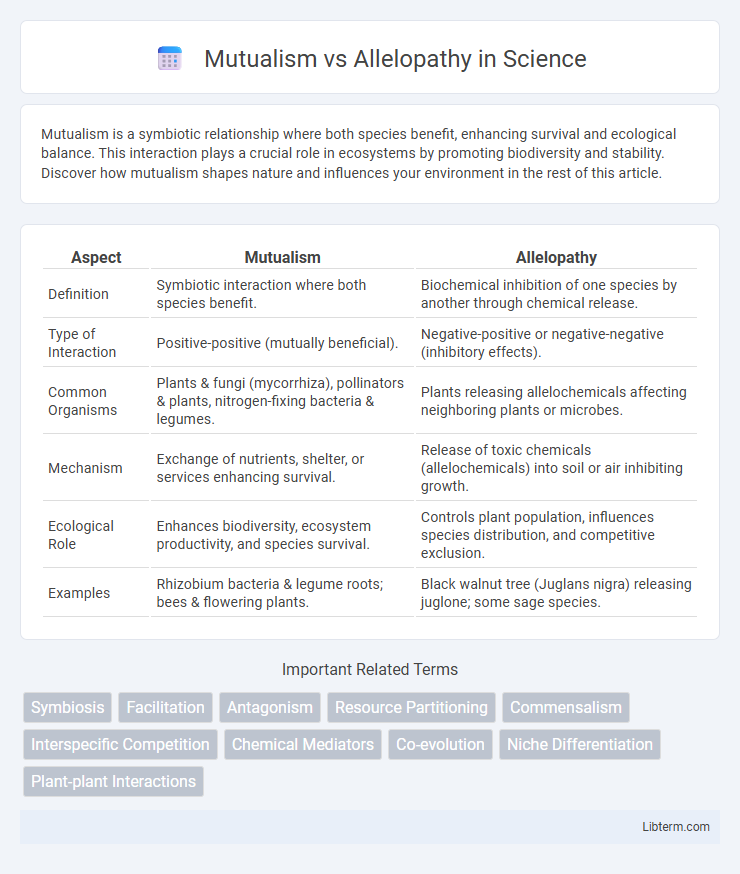Mutualism is a symbiotic relationship where both species benefit, enhancing survival and ecological balance. This interaction plays a crucial role in ecosystems by promoting biodiversity and stability. Discover how mutualism shapes nature and influences your environment in the rest of this article.
Table of Comparison
| Aspect | Mutualism | Allelopathy |
|---|---|---|
| Definition | Symbiotic interaction where both species benefit. | Biochemical inhibition of one species by another through chemical release. |
| Type of Interaction | Positive-positive (mutually beneficial). | Negative-positive or negative-negative (inhibitory effects). |
| Common Organisms | Plants & fungi (mycorrhiza), pollinators & plants, nitrogen-fixing bacteria & legumes. | Plants releasing allelochemicals affecting neighboring plants or microbes. |
| Mechanism | Exchange of nutrients, shelter, or services enhancing survival. | Release of toxic chemicals (allelochemicals) into soil or air inhibiting growth. |
| Ecological Role | Enhances biodiversity, ecosystem productivity, and species survival. | Controls plant population, influences species distribution, and competitive exclusion. |
| Examples | Rhizobium bacteria & legume roots; bees & flowering plants. | Black walnut tree (Juglans nigra) releasing juglone; some sage species. |
Introduction to Mutualism and Allelopathy
Mutualism is a biological interaction where both species involved gain benefits, enhancing their survival and reproduction, such as pollinators and flowering plants exchanging food for reproductive assistance. Allelopathy involves chemical inhibition by one plant species on the growth and development of surrounding plants through the release of biochemicals, known as allelochemicals, impacting plant community dynamics and agriculture. These contrasting ecological interactions illustrate complex relationships in ecosystems, influencing biodiversity and resource competition.
Defining Mutualism in Ecological Relationships
Mutualism is a type of ecological relationship where both species involved benefit, enhancing their survival, growth, or reproduction. This symbiotic interaction often involves nutrient exchange, protection, or pollination services that improve ecosystem stability and biodiversity. Unlike allelopathy, which involves chemical inhibition between plants, mutualism fosters cooperation and positive interdependence among organisms.
Core Principles of Allelopathy
Allelopathy involves the chemical inhibition of one plant species by another through the release of biochemicals called allelochemicals, which affect seed germination, growth, and survival. These core principles include the production, release, and persistence of allelochemicals in soil or air, influencing neighboring plant communities and ecosystem dynamics. In contrast to mutualism, which benefits species interactions, allelopathy primarily serves competitive advantages by suppressing rival plants.
Key Differences Between Mutualism and Allelopathy
Mutualism is a biological interaction where both species benefit, such as bees pollinating flowers while obtaining nectar. Allelopathy involves one organism releasing biochemicals that inhibit the growth of competing plants, like black walnut trees secreting juglone. The key difference lies in mutualism promoting coexistence and cooperation, whereas allelopathy results in competition and suppression between species.
Examples of Mutualistic Interactions in Nature
Mutualism is a symbiotic relationship where both species benefit, such as the interaction between bees and flowering plants, where bees obtain nectar and flowers achieve pollination. Another classic example is the relationship between clownfish and sea anemones, where clownfish gain protection while the anemones receive cleaning and increased water circulation. These mutualistic interactions enhance survival and reproductive success in diverse ecosystems.
Notable Cases of Allelopathy Among Plants
Notable cases of allelopathy among plants include the black walnut tree (Juglans nigra), which releases juglone compounds that inhibit the growth of many surrounding plants, effectively reducing competition. Another example is the eucalyptus species, known for producing volatile oils and phenolic compounds that suppress undergrowth vegetation. Allelopathic interactions like these significantly influence plant community structure and agricultural crop productivity.
Ecological Impact of Mutualism
Mutualism enhances ecosystem productivity and stability by facilitating nutrient cycling, pollination, and seed dispersal, promoting biodiversity and habitat resilience. Key examples include mycorrhizal fungi forming symbiotic relationships with plant roots, increasing nutrient uptake and soil health. This ecological interaction strengthens community structure and supports ecosystem services critical for environmental sustainability.
Ecological Consequences of Allelopathy
Allelopathy influences plant communities by releasing biochemicals that suppress the growth of competing species, altering species composition and biodiversity in ecosystems. These chemical interactions can reduce seed germination, inhibit root development, and affect nutrient cycling, leading to decreased plant diversity and disrupted ecological balance. The ecological consequences of allelopathy may result in monocultures or dominance of allelopathic species, impacting habitat structure and food web dynamics.
Mutualism and Allelopathy in Agricultural Practices
Mutualism in agricultural practices enhances crop productivity by promoting beneficial interactions between plants and microorganisms, such as nitrogen-fixing bacteria in legumes or mycorrhizal fungi that improve nutrient uptake. Allelopathy plays a crucial role in sustainable farming by naturally suppressing weeds and pests through the production of biochemical compounds released by certain plants, reducing the need for synthetic herbicides. Integrating mutualistic relationships and allelopathic crops supports soil health, boosts plant growth, and contributes to eco-friendly pest management strategies.
Future Research Directions in Plant Interactions
Future research in plant interactions should explore the molecular mechanisms underlying mutualism and allelopathy to enhance sustainable agriculture and ecosystem management. Advances in genomics and metabolomics can reveal specific genes and chemical compounds responsible for beneficial or inhibitory effects between plants. Integrating ecological modeling with empirical studies will improve predictions of plant community dynamics under climate change and anthropogenic stressors.
Mutualism Infographic

 libterm.com
libterm.com